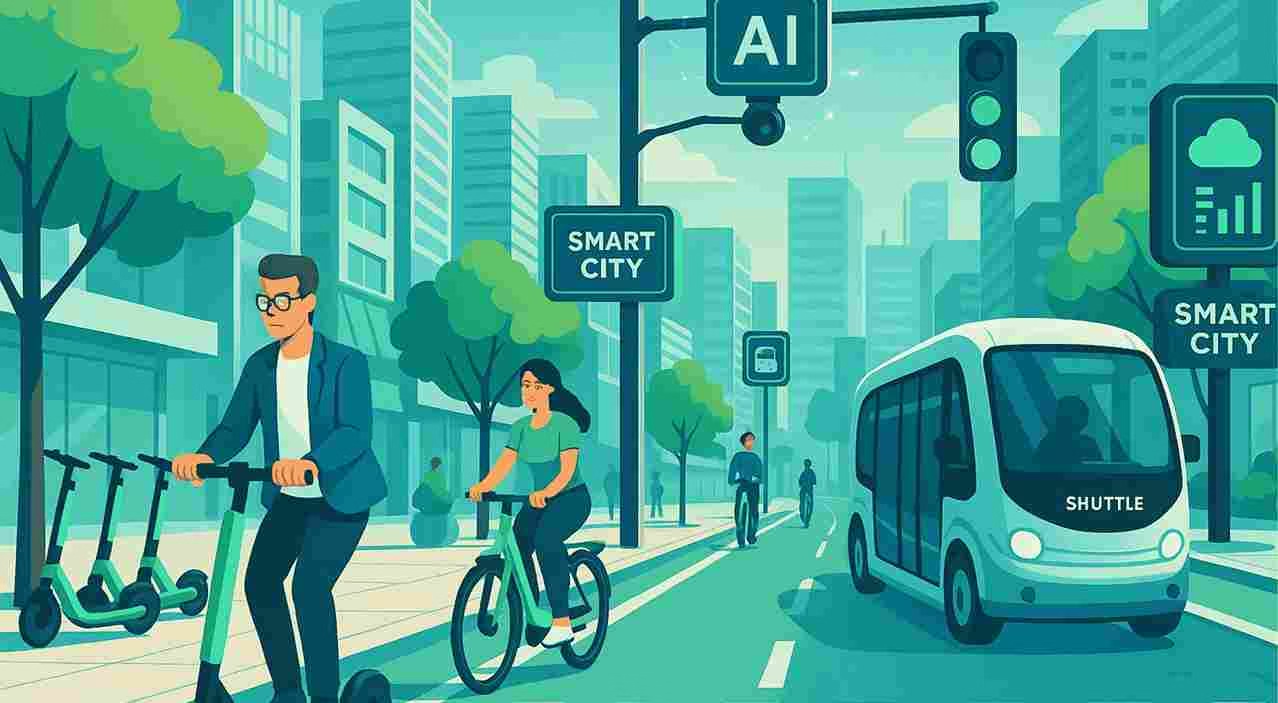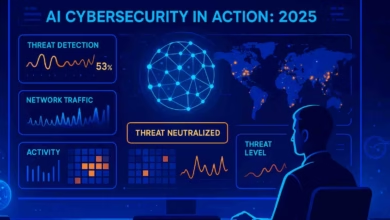Imagine a city where traffic flows seamlessly, electric scooters zip through dedicated lanes, and autonomous shuttles whisk you to your destination—all orchestrated by artificial intelligence. This isn’t a futuristic dream; it’s the reality of urban mobility in 2025. As cities grapple with congestion, pollution, and the demands of growing populations—over 68% of the world’s population will live in urban areas by 2050, according to the United Nations—smart technology is stepping in to redefine how we move. BytesWall Media Team explores the cutting-edge trends and technologies transforming city travel this year, from AI-driven systems to sustainable micro-mobility solutions.
AI-Powered Traffic Management: Smarter Streets
Traffic congestion costs cities billions annually—$87 billion in the U.S. alone in 2024, per INRIX data. In 2025, AI is tackling this issue head-on with intelligent traffic management systems. Companies like Siemens and Intel are deploying AI platforms that analyze real-time data from traffic cameras, sensors, and vehicle GPS to optimize signal timings and reduce bottlenecks. A 2025 study by McKinsey found that cities using AI traffic systems, such as Singapore and Copenhagen, have reduced commute times by up to 15% and cut emissions by 10%.
In Singapore, the Land Transport Authority’s Smart Mobility 2030 initiative, updated in early 2025, uses AI to predict traffic patterns up to an hour in advance, with 92% accuracy, according to official reports. This allows the city to dynamically adjust traffic lights and reroute vehicles, minimizing gridlock. For residents, this means less time stuck in traffic and more time for what matters—whether it’s a morning coffee run or a family outing.
AI isn’t just managing cars; it’s also integrating public transit. In London, Transport for London’s 2025 rollout of AI-powered bus scheduling has increased on-time arrivals by 12%, per TfL data, ensuring commuters can rely on buses as much as trains. These systems are also eco-friendly, prioritizing routes that reduce fuel consumption, aligning with global sustainability goals.
Electric Micro-Mobility: The Rise of E-Scooters and E-Bikes
Micro-mobility is reshaping short-distance travel in cities, with electric scooters and e-bikes leading the charge. In 2025, the global micro-mobility market is valued at $50 billion, up 25% from 2023, according to a 2025 report by Statista. Companies like Lime and Bird have expanded their fleets, with Lime reporting 200 million rides globally since its founding, as noted in its 2025 sustainability report. In Paris, e-scooter usage has surged by 30% since 2024, driven by the city’s expansion of dedicated bike lanes to 1,400 kilometers, per official city data.
E-bikes are also gaining traction, especially for longer commutes. VanMoof, a Dutch e-bike manufacturer, saw a 40% increase in sales in early 2025, according to its annual report, with its S5 model offering a range of 150 kilometers on a single charge. This makes e-bikes a viable alternative to cars for urban dwellers, reducing traffic congestion and emissions—transport accounts for 29% of global greenhouse gas emissions, per the EPA.
Technology is enhancing the micro-mobility experience. In 2025, Lime introduced AI-powered scooters that use geofencing to enforce speed limits in pedestrian-heavy areas, improving safety after a 2024 study by the European Transport Safety Council found e-scooter accidents dropped by 20% with such measures. Meanwhile, apps like Citymapper integrate micro-mobility options with public transit routes, allowing users to plan seamless multi-modal trips—for example, taking an e-scooter to a metro station, then hopping on a train.
Autonomous Vehicles: The Next Frontier
Autonomous vehicles (AVs) are slowly becoming a reality in urban mobility. In 2025, companies like Waymo and Cruise are expanding their driverless taxi services, with Waymo operating in 10 U.S. cities, including Phoenix and San Francisco, serving over 100,000 rides per month, according to its 2025 quarterly report. Cruise, backed by General Motors, launched its Origin shuttle in Austin in early 2025, offering zero-emission rides with a capacity for six passengers, as noted in a GM press release.
AVs promise to reduce human error, which causes 90% of traffic accidents, per the National Highway Traffic Safety Administration. They also optimize traffic flow—Waymo’s AVs communicate with each other to avoid congestion, reducing travel times by 10% in test areas, according to a 2025 study by the University of California, Berkeley. However, challenges remain: public trust is low, with only 37% of Americans willing to ride in an AV, per a 2025 AAA survey, and regulatory hurdles persist in many regions.
In Asia, Singapore is leading the way with its AV pilot program, launched in 2024 and expanded in 2025, where autonomous buses now serve the Punggol district, transporting 5,000 passengers monthly, per the Land Transport Authority. These buses use AI to navigate complex urban environments, integrating with the city’s traffic management system for maximum efficiency.
Challenges and Opportunities in Urban Mobility
While smart tech is transforming urban mobility, it’s not without hurdles. Infrastructure costs are a major barrier—deploying AI traffic systems can cost cities upwards of $50 million, per a 2025 Deloitte report, a steep price for budget-strapped municipalities. Equity is another concern: micro-mobility services are often concentrated in affluent areas, leaving low-income neighborhoods underserved. In Los Angeles, only 20% of e-scooter stations are in lower-income areas, according to a 2025 study by the UCLA Institute of Transportation Studies.
Yet the opportunities are vast. Smart tech can reduce urban emissions by 15% by 2030, per McKinsey, supporting global climate goals. It also enhances quality of life—shorter commutes, cleaner air, and safer streets benefit everyone. Cities like Amsterdam, which aims to be car-free by 2030, are setting the standard, with 60% of trips now made by bike or public transit, per official city data.
What’s Next for Urban Mobility
Urban mobility in 2025 is a testament to the power of smart technology. AI traffic systems, electric micro-mobility, and autonomous vehicles are not just trends—they’re the building blocks of a more sustainable, efficient urban future. As cities continue to innovate, the focus will be on inclusivity, ensuring that these advancements benefit all residents, not just the privileged few. For city dwellers, the message is clear: the way we move is changing, and it’s time to embrace the journey.
Explore more lifestyle trends on BytesWall! Discover how tech is shaping the way we live, work, and travel in 2025.
Sources
- United Nations 2025 Urbanization Report
- INRIX 2024 Traffic Congestion Report
- McKinsey 2025 Smart Cities Report
- Statista 2025 Micro-Mobility Market Report
- Lime 2025 Sustainability Report
- European Transport Safety Council 2024 Study
- Waymo 2025 Quarterly Report
- National Highway Traffic Safety Administration Data
- AAA 2025 Autonomous Vehicle Survey
- Deloitte 2025 Urban Mobility Report
- UCLA Institute of Transportation Studies 2025 Report



